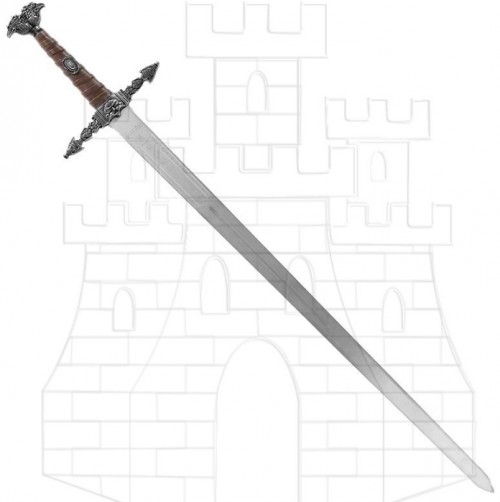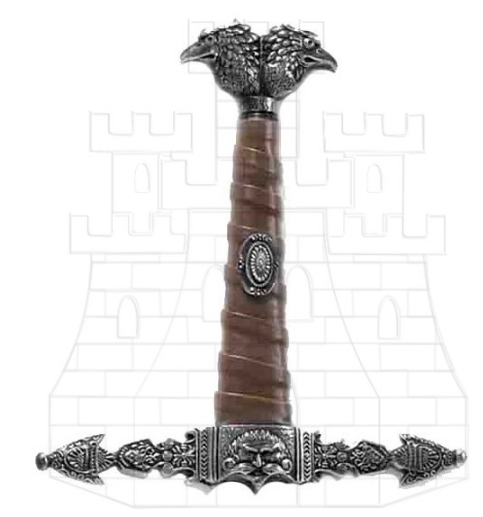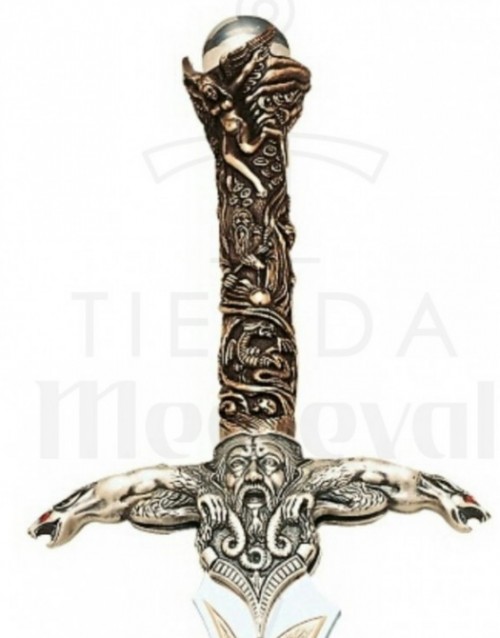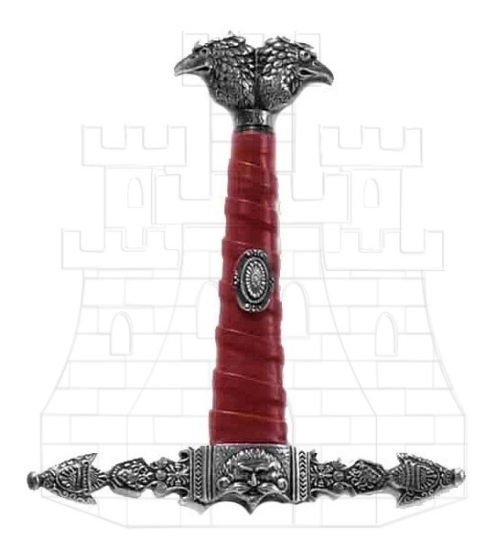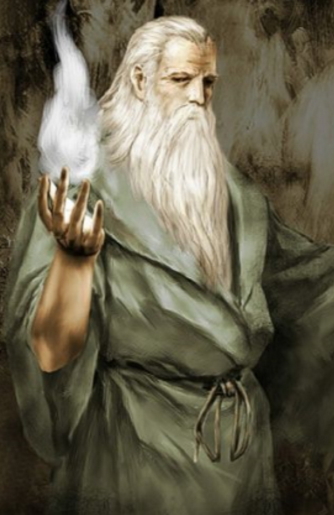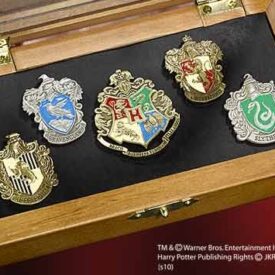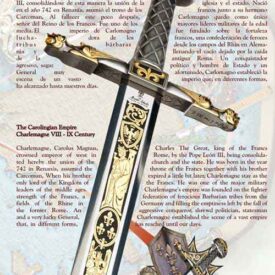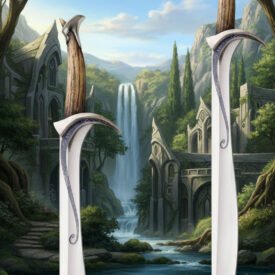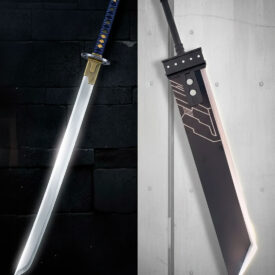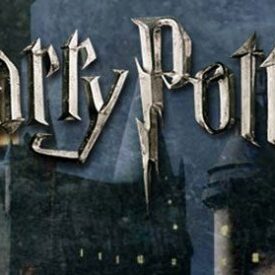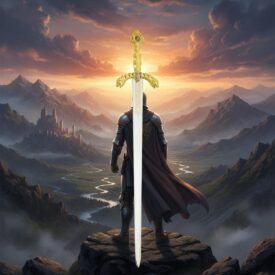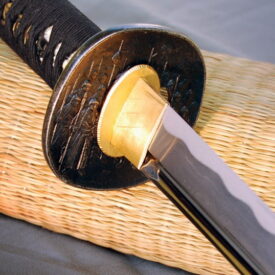Legend Has It: The Sword That Changed a Kingdom’s Destiny
What makes Merlin’s sword so irresistible to the collective imagination? Because it’s not just a steel blade: it’s a symbol that unites magic, legitimacy, and destiny. In Arthurian tradition, the sword associated with Merlin—the famed Excalibur—functions as a guiding thread between the human and the supernatural, and as tangible proof that legitimate power has a magical and prophetic origin.
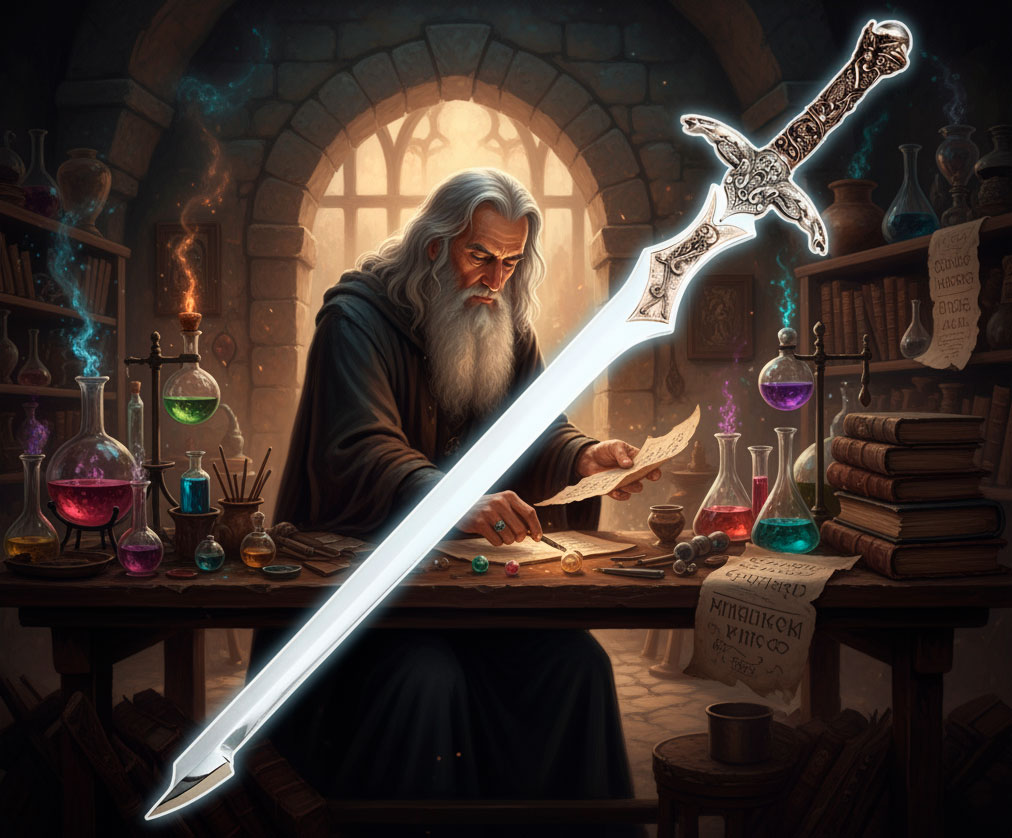
In this article, you will explore the origin of the bond between Merlin and the sword, the variants of the myth, how the figure of the wizard shaped Arthur’s destiny, and why Excalibur continues to reign in popular culture. You will also find a chronology focused on the relationship between Merlin and the sword, comparative analyses of versions, and a look at the myth’s enduring presence in literature, film, and games.
Prepare to traverse enchanted forests, stone halls, and mysterious lakes where the forging of destiny was tempered by word and prophecy.
Merlin and the Sword: Chronology of Their Relationship
| Era | Event |
|---|---|
| 6th Century AD | Origins of the figure of Merlin in Welsh folklore, a product of the fusion of traditions (Myrddin Wyllt and Merlinus Ambrosius). Merlin appears as a prophetic sage with great powers. |
| Around 1130 – c.1150 | Geoffrey of Monmouth introduces and develops Merlin in Prophetiae Merlini, Historia Regum Britanniae, and Vita Merlini; he is attributed with prophetic powers and the intelligence to move large stones (relationship with Stonehenge). |
| c.1160 (12th Century) | Robert Wace names the sword Excalibur in his Roman de Brut. In some later traditions, it is stated that Merlin forged or made the sword and that it possesses magical qualities (modern reference in King Arthur: Legend of the Sword, 2017). |
| Conception and Birth of Arthur (legend) | Merlin orchestrates the encounter between Uther Pendragon and Lady Igraine through a spell that transforms Uther, ensuring that the born child (Arthur) is given to him and entrusting his upbringing to Sir Ector. |
| Test of the Sword in the Stone (legend) | Merlin organizes the appearance of a sword embedded in a stone (or anvil) with an inscription about the rightful king; Arthur is the only one who extracts it and is recognized as king with Merlin’s guidance. |
| Reception of Excalibur by the Lake (alternative version) | In alternative versions, Arthur receives Excalibur from the Lady of the Lake; Merlin is usually present, advising and supporting Arthur in obtaining this powerful weapon. |
| Reign of Arthur | Merlin acts as Arthur’s principal advisor and mentor, participates in the consolidation of Camelot and the Round Table, and anticipates crucial events (e.g., the origin of Mordred, Guinevere’s infidelity), although his warnings are not always heeded. |
| During the training of magical apprentices | Morgana becomes Merlin’s disciple, learning “astronomy and necromancy” and becoming a powerful sorceress in some traditions. |
| End of Merlin’s Presence (legend) | Viviane (Nimue, the Lady of the Lake) learns enchantments from Merlin and, out of fear or ambition, traps him forever in crystal, rock, or tree, depriving Arthur of his advisor and foreshadowing the kingdom’s decline. Some versions suggest his soul is condemned. |
| Variants on death | In certain traditions, Merlin returns to a wild life and dies in solitude in the forests of Cornwall after witnessing fratricidal wars. |
| 20th–21st Centuries (perseverance) | The figure of Merlin and the sword Excalibur persist in literature, cinema, and video games: they appear in modern works and adaptations (e.g., films like Excalibur, The Sword in the Stone, The Last Legion, King Arthur: Legend of the Sword; authors and universes that re-examine mythical elements like Tolkien, Lewis, Rowling; and video games like Tzar: Excalibur and King Arthur: the role-playing wargame). |
Who is Merlin? The Wizard Between Prophecy and Nature
Merlin was not born at a single literary moment: he was constructed by tradition, an amalgamation of Celtic tales, Breton legends, and the imagination of medieval chroniclers. The oldest versions present him as Myrddin, a mad bard who lived in the forests, and as Merlinus Ambrosius, a court advisor. This double root explains his ambivalence: he is a man of the forest and of the court, a wise man and a supernatural figure.
His gifts reflect druidic archetypes: he speaks with beasts, knows the hidden meaning of the stars, sometimes controls the weather, and manipulates matter with his word. But he is also a prophet: he sees the thread of destiny and knows where to cut it to guide it towards a greater purpose. This blend of natural and supernatural knowledge makes him the logical guide to introduce the sword that legitimizes leadership.
It is not strange, therefore, that in many narratives Merlin is the intellectual architect behind the test that recognizes the king. Merlin not only prepares the scene: he embodies the wisdom that determines who is prepared to wield power.
Merlin as Tutor: The Forging of King Arthur
The relationship between Merlin and Arthur is a pedagogical and ritualistic bond. Merlin does not act as a mere political advisor: he molds the future king’s identity with acts ranging from the manipulation of events (such as the episode of Uther and Igraine) to the presentation of symbolic tests—the sword in the stone—that act as a seal of legitimacy. In this sense, the sword is both an instrument and a pedagogical symbol: it is the material lesson that power must respond to a moral and predestined condition.
The tale of the sword in the stone functions as a rite of passage: whoever pulls it out demonstrates not only strength but also an affinity with a truth that only the legitimate can recognize. Merlin, with his dual wisdom, is the one who decides when society needs that test.
Two Traditions, One Sword: Stone and Lake
Arthurian tales offer two major versions about the origin of Excalibur, and both emphasize the intervention of forces beyond the human. Understanding these variants helps to capture the symbolic richness of ‘Merlin’s sword’.
1) The Sword in the Stone
In the most popular version, Merlin arranges for the appearance of a sword embedded in a stone or an anvil, with an inscription proclaiming: the true king is he who can draw it. When Arthur, still a boy and raised as a squire, removes the sword, his right to the throne is proven. The scene is an act of selection: the sword acts as a visible oracle, and Merlin as its interpreter and guarantor.
2) The Lady of the Lake and the Magical Gift
In another tradition, Excalibur does not emerge from the stone but from the water. The Lady of the Lake—Viviane, Nimue, or Niniane according to different versions—gives the sword to Arthur or guards a sword in the lake that is only given to the worthy king. In many accounts, Merlin is present or intervenes from a distance to ensure that the encounter occurs, and often Excalibur’s scabbard is an even more crucial object than the blade, as it protects the wielder from mortal bloodshed.
Comparison: Versions and Attributes of the Sword
| Version | Origin | Magical Trait | Symbolic Implication |
|---|---|---|---|
| Sword in the Stone | Orchestrated public intervention (Merlin) | Proof of legitimacy; only the legitimate can draw it | Predestined sovereignty and divine judgment |
| Excalibur from the Lake | Gift from the Lady of the Lake (Viviane/Nimue) | Protective scabbard; sword with inherent magical property | Power bestowed by supernatural feminine forces |
| Forged by Merlin (variant) | Merlin as artisan/forger | Blade imbued with enchantments | Control of wisdom over military power |
These versions are not contradictory but complementary: together they show how the sword can be both a social test, a magical gift, and a ritual tool. Merlin appears in all of them as a mediator between the human world and the powers that legitimize order.
The Deep Symbolism of the Sword
The sword is a powerful symbol in European cultures: it represents authority, justice, legitimate violence, and often the intersection between the sacred and the profane. In the Arthurian cycle, Excalibur intensifies this symbolism by adding the magical dimension. It is not just a weapon: it is an emblem that transmits a mandate, a vision, and an obligation.
Merlin, as the custodian of esoteric knowledge, imbues the sword with a moral meaning: whoever wields it must govern with wisdom, or the weapon will be a cruel mirror that reflects the error and downfall of the kingdom. This idea appears in many narratives where human decisions—for example, the forbidden relationship with Guinevere—undermine the promise of unity that Excalibur symbolizes.
Merlin’s disappearance, whether through imprisonment or retirement, and the subsequent loss or symbolic loss of Excalibur mark the inexorable decline of Camelot. The sword and the wizard are, therefore, two supports of the same altar: one material, the other spiritual.
Merlin and the Transmission of Knowledge: Apprentices and Betrayals
The bond between Merlin and other magical characters, such as Morgana and Viviane, reveals a complex moral plot. Merlin teaches, shares knowledge of astronomy and necromancy, but these same kinds of knowledge can be used against him. The Lady of the Lake who granted or guarded Excalibur, in other variants, ends up being the one who traps or displaces Merlin. This thematic inversion emphasizes the fragility of the pact between power and wisdom: knowledge can save or condemn depending on who possesses it.
Sometimes Morgana, once a student, becomes an antagonist; other times, Viviane acts out of love or ambition. The narrative effect is the same: Merlin’s absence leaves Arthur incomplete and the sword, however much it may still exist, without the ultimate meaning given to it by its mentor.
The Sword in Contemporary Culture
The imprint of Merlin’s sword and the figure of the wizard spans centuries and genres. From medieval narrative to John Boorman’s Excalibur, from Tolkien’s fantasy literature to modern characters like Gandalf or Obi-Wan, the archetypal matrix remains recognizable: an elderly mentor who guides the hero, and a symbolic weapon that codifies his destiny.
In film and video games, Excalibur is more than an object: it is a plot mechanic, a narrative reward, and a visual symbol. Modern authors explore its versions to raise contemporary dilemmas: what legitimacy does power have in a secular age? Where does wisdom end and manipulation begin? These questions keep the legend alive and fuel the cultural demand for new versions.
Comparative Table: Presence of Merlin and Excalibur in Media
| Medium | Example | Merlin’s Role | Treatment of the Sword |
|---|---|---|---|
| Medieval Literature | Geoffrey of Monmouth, Robert Wace | Prophet and advisor | Object of legitimization (sword in the stone) |
| Modern Novel | Thomas Malory, Le Morte d’Arthur | Moral advisor | Excalibur as a tragic symbol |
| Film | Excalibur (1981), King Arthur (2017) | Mentor/archetype | Visual icon and plot driver |
| Video Games | King Arthur, Tzar: Excalibur | Playable or NPC character | Reward/weapon with special powers |
Why is Merlin’s Sword Still Interesting?
Because it condenses eternal questions: the relationship between power and legitimacy, the role of knowledge versus force, and the fragility of authority when separated from the wisdom that sustains it. Merlin endows Excalibur with an ethical burden that turns it into a moral mirror for the ruler. This deep and easily adaptable idea explains the multiple rewritings of the myth.
Furthermore, the sword has a perfect narrative quality: it is a visible and movable object that allows the hero’s evolution to be shown, creates trials, and catalyzes conflicts. Therefore, it continues to be used as a resource in works that address the formation of a leader, betrayal, or the loss of innocence.
How to Read the Legend Today: Three Keys for the Modern Reader
- See the sword as a symbol: beyond the material, Excalibur is a contract between the sacred and the human.
- Read Merlin as an ambivalent figure: neither solely a benefactor nor a simple manipulator; his role is that of a custodian of knowledge who decides when to intervene.
- Recognize the multiplicity of versions: each author reinterprets the myth according to their values; comparing versions reveals the cultural priorities of each era.
By adopting these keys, the myth ceases to be a medieval anecdote and becomes a tool for thinking about politics, ethics, and identity at any time.
Final Link Between Swords, Wizards, and Memory
When the figure of the wizard disappears or is betrayed, the symbol is orphaned. This loss is the lesson that many Arthurian tales leave behind: institutions without spiritual or moral guidance are doomed to fragment. If you listen to the story carefully, you will hear Merlin’s voice in the blade: a warning, a command, and a promise all at once.
VIEW MERLIN THE WIZARD PRODUCTS | VIEW EXCALIBUR SWORDS | VIEW OTHER FANTASY SWORDS
